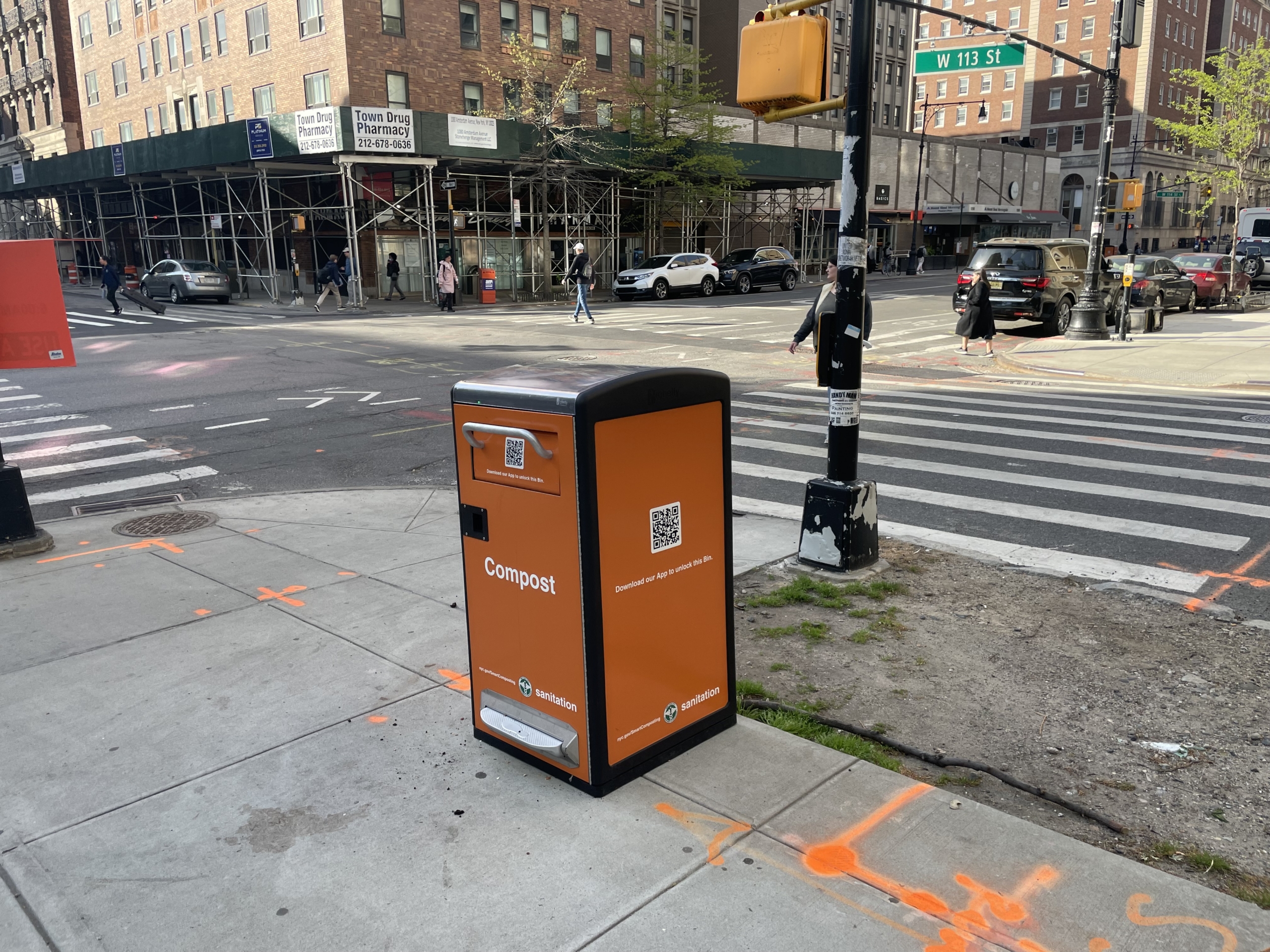
By Scott Etkin
The Department of Sanitation (DSNY) won’t fully roll out curbside composting in Manhattan until October 2024. But several “smart bins,” which are unlocked through a free app and accept food scraps, are already up and running on the Upper West Side (technically Morningside Heights, but close enough).
The bins were installed in January 2023, when DSNY expanded its pilot program, which started in Astoria, Queens in 2022, to include 250 smart composting bins across the city. Currently, Queens is the only borough to have full coverage of curbside composting — the remaining boroughs will be added over the next 18 months.
Although Manhattan will be the last borough to receive curbside compost bins, people living in the area near Columbia University already have a few bins within walking distance. DSNY didn’t provide stats on how much these specific bins have collected since January, but so far all bins in the system have been opened more than 150,000 times.
Curbside compost is a priority for DSNY because compostable material (i.e., food waste) comprises a third of the 24 million pounds of trash and recycling that New Yorkers generate each day. Food scraps that are thrown in the trash go to a landfill where they release methane, an even more potent greenhouse gas than carbon dioxide (CO2). Conversely, when food scraps are composted, they release significantly less emissions and can be used as soil, renewable energy, or fertilizer.
Here’s some basic info on how to use the bins:*
Where are the smart bins closest to the Upper West Side?
There are four smart bins located at:
- SW Corner of Broadway & 112th Street
- SE Corner of Amsterdam & 113th Street
- SW Corner of Amsterdam & 114th Street
- SE Corner of Amsterdam & 123rd Street
A full map of compost drop-off points in the City can be found at the link.
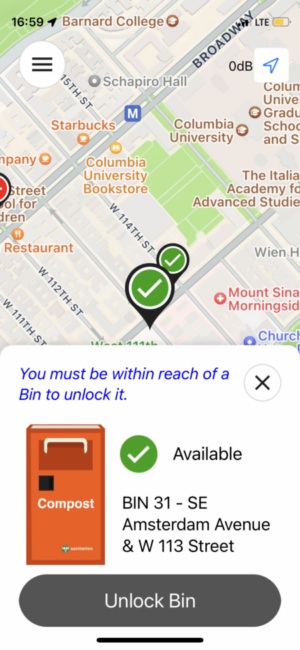
How do I use the smart bins?
First, download the NYC Compost app (available on Apple and Android).
You don’t need to input any information or sign up (it is free to use). The app will show you a map of all the smart bins in the city and if they are available for use.
The app is used to unlock the bins. To do this, click on the bin in the map you want to use and then “Unlock Bin.” You have to be within a few feet of the bin to unlock it.
When you close the door, the bin will lock again automatically.
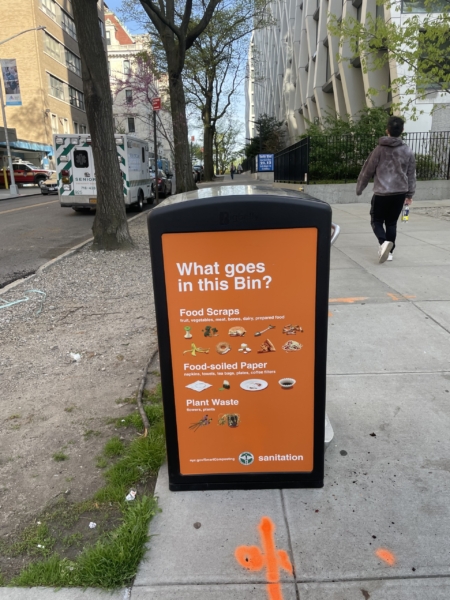
What can I put in the bin?
Smart Composting Bins accept all food scraps, plant waste, and food-soiled paper. This includes meat, bones, dairy, prepared foods, and greasy uncoated paper plates and pizza boxes.
Do NOT put recyclable materials or trash such as diapers, personal hygiene products, animal waste, wrappers, non-paper packaging, and foam products.
NOTE: Most community composting drop-off sites (such as Grow NYC farmers markets) CANNOT accept meat, fish, dairy, or food-soiled paper.
When can I use them?
Bins are available 24/7, 365 days a year. However, some bins might be unavailable if they are either full or not working. These bins will be marked as unavailable in the app.
How often are the bins emptied?
Bins are emptied at least five days a week.
When will smart composting bins become available in other parts of the City?
There are already 250 smart composting bins around the city, with some in every borough. DSNY is adding another 150 bins this summer.
Here’s DSNY’s timeline for the rollout of curbside composting service:
- March 27, 2023: Service in Queens becomes year-round. There will be no further seasonal breaks in any borough.
- October 2, 2023: Service begins in Brooklyn.
- March 25, 2024: Service begins in Staten Island and the Bronx.
- October 7, 2024: Service comes to Manhattan.
*Information sourced from the DSNY website and correspondence with the DSNY press office.


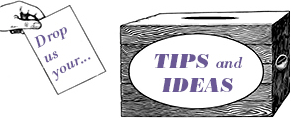



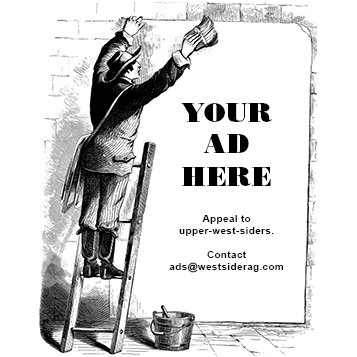



What if your compost is in bag – can that be put in too? Does it have to be in a PAPER bag or other recyclable container?
Know it need NOT be in a paper/recyclable bag
“Do NOT put recyclable materials or trash such as diapers, personal hygiene products, animal waste, wrappers, non-paper packaging, and foam products.”
This also means do NOT put the compostable items in a regular bag.
You have to empty the stuff into the bin or use a paper or compostable bag. Pro tip: the produce bags from Trader Joe’s are compostable!
The app actually requests that you DO put it in a bag to curb the mess. You may use plastic, paper, or compostable.
I stand corrected. How does that make sense though? Is someone rooting through the compost to pull out plastic bags?
I believe the plastic is separated out mechanically, via a centrifugal process
Thanks WSR for reporting on this. I’ve been waiting for these to arrive, and it’s really frustrating that the bins have been only eight blocks from my apartment since January but I never heard about them. Big communications fail by DSNY.
Used this today for the first time. Couldn’t have been easier.
Here’s a sobering reality, only a third gets composted https://www.curbed.com/2023/04/smart-bin-compost-journey.html#comments
Ok so one third is composted, two thirds is converted to biogas and 100 percent is diverted from landfills.
After they sort out the non-compostable stuff that people erroneously threw into the bin, they mix it with restaurant grease and expired milk and various other things including sewage from the water treatment plant next door, in order to produce a slurry.
Most of that slurry gets turned into biogas (and also CO2), but most of the gas produced is just used to power the facility itself. Some of it gets buried on the facility grounds, releasing enough methane into the air around the facility that private vehicles aren’t allowed on site.
5% does get sent to landfills.
The remainder, up to 25%, is not soil and cannot be used on most farms because it contains sewage. But they do find some use for it at agricultural and mining sites.
So far, none of what’s been collected from the smart compost bins has actually been composted. But they have started pumping some of the excess gas into National Grid’s supply for home heating, even as the city is trying to get people to switch away from using fossil fuels for that. Local Law 97 goes into effect next year and will begin imposing fines on buildings (including most apartment buildings) with too big of a carbon footprint.
It’s better than a landfill, to be sure. But if most of what you’re doing is turning it into methane that you then burn into CO2 in order to power your own facility, you might as well just call the whole thing an incinerator. It’s a step forward for now, but we can definitely do better.
You can read the Curbed article above for more info. The NY Times had a recent piece about it, too. https://www.nytimes.com/2023/04/19/nyregion/nyc-composting-food-waste.html
The bins are easy to use, and well designed. But the thing to know (read the Curbed article Robbie posted above) is that when the city collects compost (curbside or from the smart bins) it goes to a facility that turns it into methane, some of which is then burned (releasing CO2) and some of which just escapes into the atmosphere. It’s better than sending it to a landfill, but if you want it to actually be turned into soil, GrowNYC.org collects compost and distributes the resulting soil to community gardens around the city for free. They collect it at your local greenmarket, among other places. I now have two compost bins: Fruits and veggies go into the bag for GrowNYC and meat, dairy, paper towels, and whatever else GrowNYC can’t accept goes to the smart bin.
A laughably ineffective implementation that satisfies the political vanity and box-checking behind it.
It is so much fun to use. Also the best thing is it reduces my daily garbage output. Plus my garbage doesn’t smell so much. (the super is happier). I keep a small compost container next to my sink. When it’s full it gets dumped into a compostable produce bag if it’s mucky or a paper bag if it’s not and I run up the street to the bin. The App shows which bin is available. The first few times I was afraid I’d drop my phone in by mistake but there is a handy foot pedal that opens the bin. You need your phone to trigger the mechanism. The unintended benefit is an extra minwalk to the bins in the neighborhood. 112th St is most popular and fills up first. Such a great idea, an environmentally correct toy for the neighborhood.
Android app does not work; tech support does not respond. See comments on the Android Play Store. Works fine on my wife’s iPhone, though.